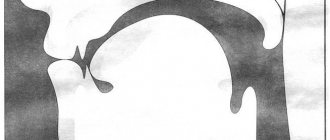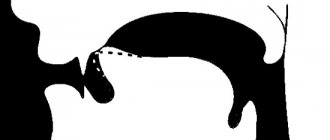| Ways to form consonants |
| Noisy Stops Plosive Africates Fricative Sibilants Sonorant Nasals Single-stroke Quivering Approximant Smooth Vowels Glide (semivowels) Lateral |
| Air currents |
| Abruptive Ingressive Implosive Clicking |
| Phonation |
| Calling start time (VOT) |
| Voiced Voiceless Aspirated |
| This page contains information about the International Phonetic Alphabet, the characters of which may not display correctly in some browsers. |
| This article or section contains an incomplete translation from English. You can help the project by completing the translation. |
Sibilants
(
whistling
) - consonant sounds, during the pronunciation of which a stream of air rapidly passes between the teeth. Examples of words beginning with sibilants are: "juice", "beast", "shield", "hour". In the IPA, the signs [s] [z] [ʃ] [tʃ] [dʒ] [ʒ] are used to denote sibilants. The sounds [tʃ] [dʒ] are affricates.
Sibilants are intense sounds that are used to attract attention: “t-s-s”, “sh-sh-sh”.
Sibilants are easy to distinguish even with small differences in tension, shape and position of the tongue, which is why in many languages of the world different sibilants are opposed to each other.
Types of sibilants[ | ]
All sibilants are coronal consonants (the sound is produced by the front edge of the tongue), but there are many types of sibilants.
- according to the shape of the tongue: alveo-palatal consonants, palato-alveolar consonants, retroflex consonants;
- by place of articulation: dental consonants, dental-alveolar consonants, alveolar consonants, postalveolar consonants, palatal consonants;
- at the point of contact of the tongue: laminal consonants, apical consonants, subapical consonants.
Natural languages typically have series of consonants: laminal dental-alveolar sibilants exist in Polish, and subapical palatal retroflex sibilants exist in Toda.
Types of sigmatism
All forms of sigmatism are divided into two large groups: hissing sigmatism and whistling sigmatism. The methods for correcting defective sound pronunciation depend on the nature of the distortion of sounds. The main types of sigmatism in both groups of sounds are identical:
- Interdental.
The tip of the tongue takes a position between the upper and lower incisors. Phonemes acquire a lisping sound. - Prizubny.
The tongue rests against the edges of the incisors, blocking the passage of air through the interdental gap. The sound produced is acoustically close to [T]. - Labial-dental.
The lower lip comes closer to the upper teeth, the air comes out in a jerky manner. Instead of the correct sound, a distorted [F] or [V] is heard. - Side.
The exhaled air stream exits through a one-sided slit or along both lateral edges of the tongue. The sound is noisy and squelching. - Nasal.
During phonation, air does not come out through the mouth, but through the nasal cavity. Because of this, the sound has a snoring sound with a nasal tint.
In addition, hissing [Sh], [Zh] may have other types of distortion that are characteristic only of them:
- lower
- the tongue is lowered behind the lower incisors, hissing sounds are pronounced softly; - buccal
- the air stream goes into the cheeks, causing them to swell, instead of sound a noise is heard; - posterior lingual
- air passes between the hard palate and the back of the back of the tongue, a “hunting” or “whooping” is heard, reminiscent of the southern Russian dialect.
Symbols in IPA[ | ]
The following table shows the types of sibilant fricatives defined in the International Phonetic Alphabet:
IPA signs for sibilants
| Deaf | Voiced | ||||||||||
| MFA | Description | Example | MFA | Description | Example | ||||||
| Language | Spelling | MFA | Meaning | Language | Spelling | MFA | Meaning | ||||
| voiceless alveolar sibilant | English | sip _ | [ sɪp ] | "a sip" | voiced alveolar sibilant | English | z ip | z ] | "zipper, clasp" | ||
| voiceless alveolo-palatal sibilant | Putonghua | 小 ( xiǎo ) | [ ɕ iɑu˨˩˦] | "small" | voiced alveolo-palatal sibilant | Polish | zi oło | ɔwɔ] | "grass" | ||
| Russian | sch ac decom. | [' ɕ as] | "Now" | ||||||||
| voiceless palato-alveolar sibilant | English | shin | [ ʃɪn ] | "shin" | voiced palato-alveolar sibilant | English | vi s ion | [ vɪʒən ] | "vision" | ||
| voiceless retroflex sibilant | Putonghua | 上海 ( Shànghǎi ) | ɑ̂ŋ.xàɪ] | "Shanghai" | voiced retroflex sibilant | Polish | żaba | abə] | "toad" | ||
| Russian | joke _ | ['ʂutkə] | "joke" | Russian | toad | ||||||
Diacritics can be used for greater detail. For example, the apical and laminal alveolar may be specified as [s̺] instead of [s̻]; dental (or most likely dento-alveolar
) sibilant - like [s̪]; palatalized as [sʲ]; and “general retracted sibilant” - as [s̠], and the transcription is often used for the type of qualitative retroflex consonants. There are no diacritics to indicate the laminal “closedness” of articulation of the palatal alveoli in North Caucasian languages, but they are often written as [ŝ ẑ].
WHISTLING SOUNDS [С, 3, Ц] AND THEIR SOFT PAIRS
Pronunciation of the sound [s]: The lips are extended into a smile, the teeth are brought together in the form of a normal bite. The lateral edges of the tongue are pressed against the molars. A groove is formed along the midline of the tongue, along which an air stream flows, like a whistle. The tip of the tongue can rest against both the lower and upper incisors. A stream of air is clearly delivered to the teeth itself (Fig. 12, 13).
The sound
[s] should sound like a thin whistle; if some coarser noise is added to the whistle, then the sound is pronounced incorrectly.
The sound [z] is pronounced the same way, only the sound of the voice is added.
The sound [ts] is formed as a result of the rapid sequential pronunciation of the sounds [t] and [s] ([ts]).
3. The tip of the tongue leans against the teeth not in the center, but slightly to the left or right, the air flows around the obstacle from one of the sides. A smooth, but rough whistle with a hissing tinge is heard. The lips can be in an asymmetrical smile. Methods of setting - III, VII.
Any variant of lateral pronunciation can be detected by placing your palm to the child’s mouth, on it you will feel from which corner of the mouth the air is coming out.
• Whistling sounds can be replaced with regular or defective hissing sounds: [s] - with [sh] (sometimes somewhat softened [sh]), ([z] and [ts] - with [zh] and [tsh]. Methods of production - I, I, III, IV, VII.
• The sound [s] can be replaced by a full or distorted (resembling [sch]) soft sound [s'] ([z] - [z'], [ts] - [t's']). The setting method would be I, II, III, IV, VII.
• The pronunciation of soft sounds [s'] and [z'] may be disrupted in the same way as the pronunciation of their hard pairs, but may remain correct.
Words to check the pronunciation of whistling sounds:
[s] - garden, dream, mustache, wasp, pasta, basma, samsa, clips, x, fox [s'] - hay, aspen, autumn, oatmeal, brush (pronounced kis't). pug, pension
[h] - plant, itch, goat, Lisa, sleeve, alphabet, sigh, enema, prisoner
[z'] - Zina, finch, physics. Asia, monogram, Pilsen
[ts] - heron, mat, bird, fingers, ounce, accent, Aztec, option
SIZZING SOUNDS [SH, F]
Pronunciation of the sound [sh]: The teeth are close together, the upper incisors are directly above the lower ones, the lips are rounded and pushed forward. The sides of the tongue are pressed against the upper molars. The widened, flattened tip of the tongue touches the alveoli slightly in front, the middle part of the tongue bends down, that is, the tongue has the shape of a “bucket”. The air stream passes between the tip of the tongue and the alveoli. If the tip of the tongue touches the very top of the alveoli, the sound will be harsh (Fig. 16).
The voiced [zh] is formed in the same way, only the sound of the voice is added. The pronunciation of the sound [zh] should not be too harsh, but slightly softened, so that the sound sounds pleasant to the ear, thick and velvety. If you hear a harsh pronunciation, it means that the tongue is most likely too deep in the mouth. The same applies to the sound [w]. It should “rustle” softly and have a slightly noticeable whistling tint, and not be pronounced dull and harsh.
When pronouncing a voiced sound [zh], the defective pronunciation is more noticeable, so sibilants are often more convenient to check by sound [zh].
Types of incorrect pronunciation of sounds [sh, zh]:
• The tongue may be retracted into the back of the mouth and not participate in pronunciation. Then the air passes noisily between the clenched teeth (both incisors and molars). Any method of setting.
• Sometimes the lips are involved in such pronunciation, one way or another. They can press against the front teeth, then an additional overtone of the sound [f] (or [v] when pronouncing the sound [zh]) appears. Any method of setting.
• The lips can be put forward, in this case 2 pronunciation options are possible:
1. Air can “hit” both cheeks (sometimes more strongly on one), so that when a sound is pronounced with force, the child’s cheeks swell. However, a slight “blow” of air on the cheeks can be felt during normal pronunciation, if you lean your palms against them. The sound is sloppy, “squelching”. Any method of setting.
2. When trying to improve pronunciation, a child can press his cheeks against his molars to prevent air from escaping to the sides. The sounds ki [sh, zh] are then similar to those that are normally pronounced. This is achieved, among other things, by excessively extended lips. Ask your child to show where his tongue is. Any method of installing a new one.
• The tip of the tongue can be pressed behind the lower teeth, and the back can be arched into a “hump.” Then the air, rustling, passes between the highest place of the back and the alveoli. Sounds sound softer than necessary. In this case, the lower lip (and sometimes the lower jaw) protrudes forward more than the upper. Any method of setting. Some children are very good at “faking” the correct pronunciation of hissing sounds in this position, so that it can be difficult to distinguish them from “real” ones. You need to check the wear of sounds in consonant clusters and see where the tongue is.
• Sounds can be pronounced in a “sideways” manner. An air stream with a “sob” passes between one of the cheeks and the molars.
teeth. With your palm you can feel the movement of air at one of the corners of your mouth. The lips may occupy an asymmetrical position. Methods of setting - I, III, IV.
Possible sibilants[ | ]
| IPA | Tongue shape | Place of articulation (mouth) | Place of articulation (tongue) | Example |
| [s̺̪ z̺̪] | flat | dental | apical | Spanish s/z |
| [s̪ z̪] | flat | dental-alveolar | laminal | Polish s, z ; Basque z, tz |
| [s̺z] | flat | alveolar | apical | northern dialects of Spanish s ; Basque s, ts ; Mandarin s, z, c (apical, dental, or alveolar) |
| flat | alveolar | apical or laminal | English s, z (alv., lamin., or ap.); Spanish with American accent s/z | |
| [s̻z] | flat | alveolar | laminal | Toda, Ubykh, Abkhazian |
| [ʃ ʒ] | domed | postalveolar | apical or laminal | English sh, ch, j, zh and French ch, j ([ʃʷ ʒʷ]) |
| [ʃ̻ ʒ̻] | domed | postalveolar | laminal | then yes; Basque x, tx |
| [ɕʑ] | palatalized | postalveolar | laminal | Mandarin x , j , q ; Polish ć , ś , ź , dź ; Ubykh; Abkhazian |
| [ŝẑ] | flat | postalveolar | laminal | Ubykh; Abkhazian |
| [s̱ ẕ], [ʂ̻ ʐ̻] | flat or tongue raised | postalveolar | laminal | Polish sz, rz, cz, dż ([ʂ̻ʷ ʐ̻ʷ]); Mandarin sh, zh, ch |
| [ʂ ʐ], [ṣ ẓ] | flat | postalveolar | apical | Ubykh; Abkhazian; then yes |
| [ʂʐ] | bent up | palatal (or postalveolar?) | subapical | then yes |
Making whistling sounds
A child begins to pronounce whistling sounds correctly at about 3-4 years of age. But some children have problems with articulation. If measures are not taken promptly, speech dysfunction will persist for life. To create whistling sounds, a set of special exercises is usually prescribed. They are performed both in classes with a speech therapist and at home.
The importance of making a whistling sound
Speech defects that develop in childhood can lead to communication difficulties in adulthood. Therefore, the production of whistling sounds must be carried out in a timely manner. The earlier a deviation is detected, the greater the chances of its successful elimination. Typically, defects become noticeable when the child enters the middle group of kindergarten. Speech therapists distinguish two types of disorders:
With sigmatism, the child’s pronunciation of the sound “s” in soft and hard forms is distorted. With parasigmatism, its replacement occurs. Deviations in spoken language can have a negative impact on the functioning of the nervous system. This subsequently leads to low self-esteem and communication disorders. Against the background of incorrect pronunciation, the following develops:
Hissing sounds: where to start staging
We show the child a card with the sound Ш, draw a phoneme, explain how the tongue is located: now it is at the top, the edges are pressed tightly against the molars. Instead of the phrase “sound Ш” it is better to say “warm wind”, “snake hisses”, “inflate the balloon”.
Articulatory gymnastics for staging hissing (exercises by L.A. Komarova)
- “Cup”
- the mouth is open. Raise a wide, relaxed tongue to the upper lip. Bend the middle part of the tongue and bend the side edges upward. It turns out to be a cup. We take the “cup” inside and take it back out. Do this several times. - “Horse”
- “glue” the tongue to the palate. Thus, the hyoid frenulum is stretched. The lower jaw remains motionless. With a click, we “unstick” the tongue - the “horse” clicks. - “Fungus”
- “glue” the tongue to the palate, open the mouth wide. Hold this position for several seconds. - “Accordion”
- make a “mushroom”. Only now we open and close our mouth, stretching the hyoid frenulum. Keep your tongue “glued” to the palate, lips in a smile. - “Swing”
- mouth wide open. Stretch your tongue either to your nose or to your chin. - “Donut”
– mouth slightly open, lips extended slightly forward and rounded.
“Let’s warm our palms” - imagine that your hands are frozen in the cold. Open your mouth, stretch your lips forward, exhale “x-x-x”, warming your palms.
The exercises that are performed when setting C, “Punish a naughty tongue”, “Spatula”, “Candy”, “Jam”, “Brushing teeth” are repeated when setting Sh. You don’t need to do everything, choose 5-7 of any articulation exercises, and also remember about the development of the air stream.
Ways to make the sound Ш
In front of the mirror, we ask the baby to blow a cold wind onto his palm. Now invite the child to “cup” his tongue by the upper teeth onto the alveoli and try to say “ssss” again. In this position of the tongue you will hear “sh-sh-sh”. If it doesn’t work out, you can hold the roll stick between your teeth (your tongue should lie on the stick, not under it) and blow. Or use a clean finger to hold your tongue up. It is important to explain to the baby that the wide tongue should be behind the upper teeth - then “the snake will hiss.”
After successful consolidation of Ш, we obtain the sound Ж in the same way as the phoneme Z. We place our palm on the throat and ask the child to compare hissing and buzzing: “sh-sh-sh” - the throat is calm, “zh-zh” - the throat is trembling.
To get H, ask your baby to say a soft "t'-t'-t'" and gently move his tongue slightly deeper into the mouth using a spoon/q-tip/clean finger. The sound SH should appear automatically. We fix each phoneme according to the scheme, teach the child not to confuse whistling and hissing. For this purpose, learning poems where both types of sounds are found, and games for differentiating phonemes are suitable.
10 books for automating sounds
- “Speech therapist lessons. Correction of speech disorders”, N.S. Zhukova.
- “Album of a preschooler. Automation of sounds in game exercises”, L.A. Komarova.
- “We learn sounds. Home speech therapy notebook for children 5-7 years old,” E.A. Azova, O.O. Chernova.
- “We pronounce the sounds correctly. Speech therapy album for children 4-8 years old,” T.A. Tkachenko.
- “Home notebook for speech therapy sessions with children”, Yu.B. Zhikhareva-Norkina.
- “Games with paired cards. Speech therapy board games for children 5-7 years old”, Z.T. Bobyleva.
- “I speak correctly”, didactic material by O.E. Thunderous.
- “We are speaking correctly. Games for speech development”, E.M. Kuritsyna, L.A. Taraeva.
- “Album for automating sound pronunciation”, O.I. Lazarenko.
- “Speech therapy album. We speak correctly,” T.S. Reznichenko, O.D. Larina








